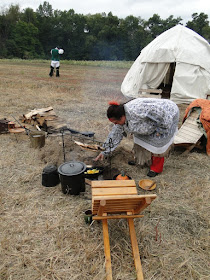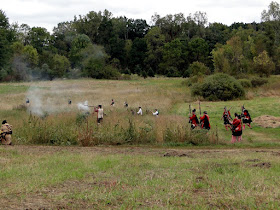 |
| Light for dinner (photo by Ian Kushnir) |
And it was a rousing success on all accounts!
So here we are, now, five years later...Wolcott Mill is no longer, but we have continued presenting Harvest Home every year since, though in different locations, including Detroit's Historic Fort Wayne. However, this year, the Village of Armada, a beautiful quaint small-town American village at its best, located in northern Macomb County, was celebrating the sesquicentennial (150th) anniversary of its founding.
And we, the civilians of the 21st Michigan, were asked to take part.
For whatever reasons we did not have as many from our unit show up this year. But that's okay, for those of us who did participate had a splendid time indeed, and showed hundreds of visitors a bit about harvest life from 150 years earlier.
So - - are you interested in how it all went?
Good!
Here you go - - :
 |
| Our little set up in a park just north of the quaint Village. It was perfect for what we were doing. And it just felt like fall! |
 |
| My wife was there on Saturday and was a huge hit with her spinning wheel. |
 |
| She let a few of the youngsters try carding the wool with her carding paddles. |
 |
| Jackie spoke of canning and pickling and other forms of food preservation, as well as a bit about yarn and spinning when my wife was away. |
Although we put on a historic presentation, we also made sure there was time for visiting with each other, for we all are very good friends:
 |
| Mrs. Alto and my son, Robbie. |
 |
| I was paid a visit by the Armada Queen and her Court! (Photo by Kevin Grande) |
 |
| Some of our ladies: Jennifer, Larissa, and Jackie. |
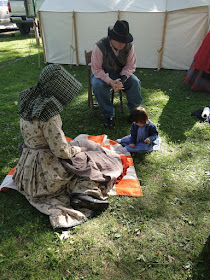 |
| Carrie and Ian Kusnir, with their little one, Nadia, also came out and spent the day with us as well. |
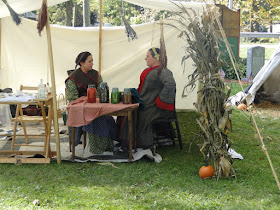 |
| Though some thought otherwise, the weather was fine indeed. Yes, a little on the nippy side, but it's October in Michigan! Yes, fine indeed, indeed! |
 |
| The Woodruffs always celebrate the harvest in such a great way. Their set up is second to none. |
 |
| They even bring their chickens out! |
 |
| Of course, the kids (and Kristen) always seem to enjoy shelling corn. |
 |
| Carla Woodruff brought along her lap (or mountain) dulcimer. |
 |
| I took a turn playing the lap/mountain dulcimer. I do know how to play, though very basically. Here you see me playing one of my favorite period tunes, "Long Long Ago," which was written in 1833. |
 |
| Mrs. Cook was out, frying up doughnuts for everyone. |
 |
| We had cider making with the press that the 21st Michigan purchased. |
 |
| As you can see we use a variety of apples to give our cider a very special taste - - a little sweet with a bite. |
 |
| The process of making apple cider: carefully toss the apples in the hopper turn the crank to grind the apples the apples pieces fall into the barrel below to be mashed down so that every bit of juice can be squeezed out |
 | ||
Larissa spoke of (and made) sauerkraut.
|
 |
| Carla was peeling apples for sauce. |
 |
| Vern churns butter - he makes the best! |
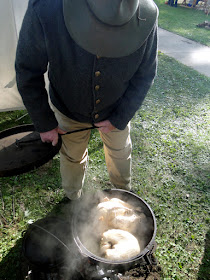 |
| For our thresherman's dinner, Ken Alto cooked my favorite dish - a fine turkey! |
 |
| Some of the food we shall eat! (Pic by Ian Kushnir) |
 |
| And we did have quite a feast of food at hand for all of us for our thresherman's dinner. (Image courtesy of Ian Kushnir) |
And, for the 6th year in a row, we had one just the same!
 | ||
| Our own fall harvest meal, held outdoors in the crisp, cool air of autumn, was, simply put, wonderful to participate in.
|
 |
| My bride and I enjoying ourselves at the thresherman's dinner, which was also a sort of Thanksgiving dinner as well. |
Then there was the Armada Sesquicentennial parade:
 |
| Our marchers were ready with their muskets and, er, crock. |
 |
| The Michigan Wheelmen were part of the parade as well, along with firetrucks, Armada Queen, marching band, and... |
 |
| ...the proud 21st Michigan marchers! No, Larissa did not carry her crock, only the parade number . |
 |
| Just what are they carving? |
And as you continue to read, you will learn a little about the turnip and its connection to Hallowe'en...
 |
| The sun prepares to set in the western skies, casting long shadows on this October harvest...daytime begins to wane... |
The traditional illumination for guisers or pranksters abroad on the night was provided by turnips or mangel wurzels, hollowed out to act as lanterns, lit with coal or a candle, and often carved with grotesque faces.
Turnip lanterns usually represented supernatural beings and were used to chase evil spirits. Guisers used them to scare people, while in some cases they were set on windowsills to guard homes against evil.
Irish immigrants brought the jack-o’-lantern custom to North America. Here, turnips were slowly replaced by pumpkins to make the iconic Halloween decorations, and eventually became the plant of choice.
 |
| Turnips for Hallowe'en |
But here in America it is all celebrated in a myriad of different ways by as many different people. Adaptations of Washington Irving's "The Legend of Sleepy Hollow" (1820) often show the Headless Horseman with a pumpkin or jack-o'-lantern in place of his severed head. In the original story, a shattered pumpkin is discovered next to Ichabod Crane's abandoned hat on the morning after Crane's supposed encounter with the Horseman.
The application of the term to carved pumpkins in American English is first seen in 1834.
Something I was not familiar with is that October’s Full Moon is known as the Hunter’s Moon. Hunter's moon is mentioned in several sources as the Anglo-Saxon name for the Full Moon of October. This is the month when the game is fattened, and it is time to start preparing for the coming winter. Traditionally, this included hunting, slaughtering and preserving meats for use in the coming winter months.
Just so I could learn the difference between the harvest moon, the full moon, and the hunter's moon, the Full Moon closest to the September equinox is called the Harvest Moon, and it is either in September or October. Most years, the Harvest Moon is in September, but around every three years, it is in October. And, as mentioned, Hunter's moon is October's full moon.
 |
| Since we had the Harvest Moon already this year (September), this full moon for mid-October is the Hunter's Moon, just in time for our harvest presentation---perfect! |
Simply put, both the Harvest moon and Hunter's moon are full moons with names and dates attached.
And there you have another successful harvest with a few of the 21st Michigan civilians.
If you are a longtime reader of Passion for the Past, then you know how much of an autumn person I am. It is just such a wooden...natural time of year.
I want to personally thank the members of the 21st Michigan who participated in our harvest. I am so very thankful to the following (yes, their names deserve to be listed):
Jackie Alto
Ken Alto
Heather Bradley
Candy Cary
Jim Cary
Jean Cook
Larissa Fleishman
Miles Giorlando
Patty Giorlando
Robbie Giorlando
Carrie Kushnir
Ian Kushnir
Nadia Kushnir
Jennifer Long
Kristem Mrozek
Jackie Schubert
Carl Woodruff
Carla Woodruff
Marianne Woodruff
Vern Woodruff
Verny Woodruff
.......................
But I must say, our harvest home event just might be one of my most favorite of all, for it truly brings the fall and harvest and all the glories of America past together...community.
And, yes, we will be back harvesting again in 2020. Will we return to Armada? That awaits to be seen. If they have us, then I would say we most likely will.
Harvest Home everyone!
Until next time, see you in time.
 |
| Thank you, Armada! |
~ ~ ~





















